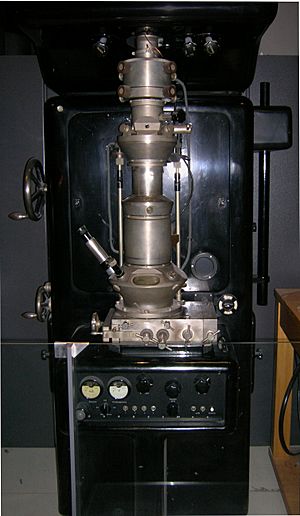Ernst Ruska facts for kids
Quick facts for kids
Ernst Ruska
|
|
|---|---|
 |
|
| Born |
Ernst August Friedrich Ruska
25 December 1906 |
| Died | 27 May 1988 (aged 81) |
| Nationality | German |
| Alma mater | Technical University of Berlin Technical University of Munich |
| Known for | Electron Microscopy |
| Awards | Albert Lasker Award for Basic Medical Research (1960) Duddell Medal and Prize (1975) Robert Koch Prize (Gold, 1986) Nobel Prize in Physics (1986) |
| Scientific career | |
| Fields | Physics |
| Institutions | Fritz Haber Institute Technical University of Berlin |
| Doctoral advisor | Max Knoll |
| Notes | |
|
Ernst Ruska constructed the first transmission electron microscope (TEM) with his mentor Max Knoll
|
|
Ernst August Friedrich Ruska (born December 25, 1906 – died May 27, 1988) was a German physicist. He is famous for his amazing work with electron optics. This led him to design and build the very first electron microscope. For this important invention, he won the Nobel Prize in Physics in 1986.
Contents
Ernst Ruska's Early Life and Studies
Ernst Ruska was born in Heidelberg, Germany. He loved learning about science. He went to the Technical University of Munich from 1925 to 1927. After that, he moved to the Technical University of Berlin.
While studying, Ernst had a brilliant idea. He thought that microscopes could see much smaller things. Regular microscopes use light. But light waves are quite long. Ernst thought about using electrons instead.
Why Electrons Are Better for Microscopes
Electrons are tiny particles. They have very short wavelengths. These wavelengths are about 1,000 times shorter than light waves. This means electrons could show a much clearer and more detailed picture. It would be like zooming in super close on something tiny.
In 1931, Ernst proved his idea. He showed that a special magnetic coil could act like a lens. This "electron lens" could focus electrons. He then used several of these coils together. This allowed him to build the very first electron microscope in 1933.
Developing the Electron Microscope
After getting his PhD in 1933, Ernst Ruska kept working on electron optics. He worked at different companies. One of them was Siemens-Reiniger-Werke AG. At Siemens, he helped create the first electron microscope that could be sold to others. This happened in 1939.
Working with His Brother
Ernst also encouraged Siemens to open a special lab. This lab was for other scientists to visit and use the new technology. His brother, Helmut Ruska, was a medical doctor. Helmut led this new lab. He found ways to use the electron microscope for medicine and biology. This helped doctors and scientists study tiny cells and viruses.
Later Career and Awards
Ernst Ruska left Siemens in 1955. He then became the director of the Institute for Electron Microscopy. This institute was part of the Fritz Haber Institute. He worked there until 1974. At the same time, he was also a professor at the Technical University of Berlin. He taught there from 1957 until he retired in 1974.
Winning the Nobel Prize
Ernst Ruska received many awards for his important work. In 1960, he won the Lasker Award. The biggest award came in 1986. He was given half of the Nobel Prize in Physics. This was for all his amazing achievements in electron optics. Two other scientists, Gerd Binnig and Heinrich Rohrer, also won part of the prize. They won for inventing a different type of microscope called the scanning tunneling microscope.
Ernst Ruska passed away in West Berlin in 1988. His work changed how scientists study the world around us.
A Special Asteroid
An asteroid, 1178 Irmela, is named after his wife, Irmela. She was the niece of the astronomer Max Wolf, who discovered the asteroid.
See also
 In Spanish: Ernst Ruska para niños
In Spanish: Ernst Ruska para niños


